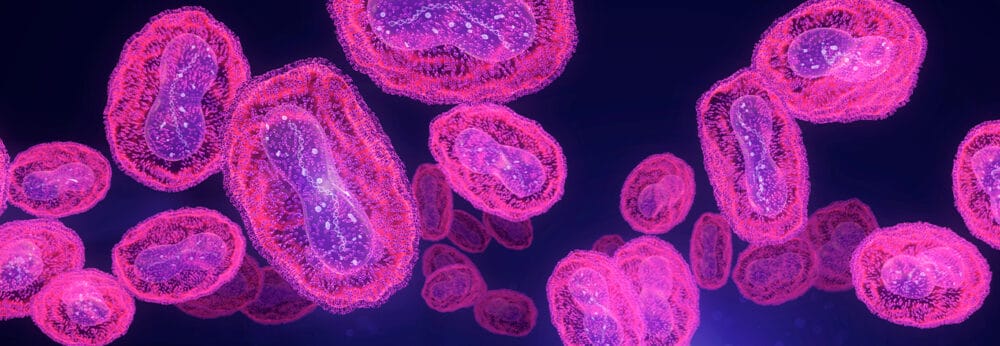Posted
15th August 2022
Events and Exhibitions
In this article, our Clinical Specialist for Consumables, Michael Sanni, discusses a poster on GAMA’s products presented at ECCMID on “The impact of bedside wipes (for environmental cleaning) in multi-patient rooms”.
Lisbon, Portugal, was home to the 32nd annual European Congress of Clinical Microbiology and Infectious Diseases (ECCMID) which was their first face to face conference for over 2 years due to COVID.
Related article: Highlights from ECCMID 2022

Poster presentations at ECCMID
Across the 4 days, the conference consisted of talks by global experts and poster presentations about ongoing research, several included studies of GAMA products.
One study presented by the Infection Control team from North Lincolnshire & Goole NHS Foundation Trust, highlighted how they reduced hospital-onset COVID-19 cases by introducing Rediroom.
Find out more here: How North Lincolnshire & Goole transformed their isolation approach with Rediroom
Today, we discuss the poster presented on the impact of bedside wipes (for environmental cleaning) in multi-patient rooms: a prospective, crossover trial comparing infections and survival in hospitals.
Where did the study take place?
This study took place in Be’er Ya’akov, Israel, with the aim of quantifying the impact of placing single-use cleaning/disinfecting wipes, in patients’ immediate environment with multi-patient rooms. Some of the pre-specified outcomes were the following:
- Healthcare associated infection (HAIs) rates.
- New multi-drug resistant organisms (MDRO) acquisitions.
- Mortality.
- Cleaning frequency.
- MDRO room contamination.

How was the study designed?
The study design and protocol consisted of a cluster randomised crossover study (CRT is a trial in which groups of individuals are randomised) covering 4 medicine departments at Shamir Medical Centre. Over the 15 months, from October 2016 – January 2018, 5 touch locations were marked to assess the level of cleanliness (twice a week), as well as the presence of MDROs to assess environmental contamination. These locations included:
1. Right bedrail.
2. The tray of the bedside table.
3. Under the binder that contains the fluid balance pages, hanging at the foot of the bed.
4. The nurse’s call-on button.
5. The lamp switches.
The study protocol consisted of three distinct locations: High touch surfaces for regular rooms and high touch surfaces with known C.difficile rooms, also floors, bathrooms and sinks. During the control phase standard hypochlorite reusable cloths (1,000ppm for routine disinfection and 5,000 ppm in rooms with known C. difficile cases) were used across all the locations and were located next to each patient bed space. During the intervention phase, both Clinell Universal and Peracetic Acid Wipes were used however hypochlorite wipes were still used for floors, bathrooms, and sinks.
Related article: Surface disinfectant wipes: are you asking the wrong questions?

Results
The poster illustrates no significant difference in device-related HAI rates, such as central line associated blood stream infections, and catheter-associated urinary tract infection (CLABSI, CAUTI). However, between the groups in intervention rooms, three major outcomes were observed:
- In-hospital mortality rate was lower.
- New MDRO acquisition rate by new patients was lower.
- MDRO environmental contamination rate was lower (HR=0.44, p= 0.038).
What can we learn from these results?
It was evident that merely making the single use cleaning and disinfecting wipes (Clinell Universal) more widely available did not directly affect the HAI rates. However, implementing training on product use and effective cleaning did support the frequency of cleaning and reduce MDRO environmental contamination. This poster posits a feasible, recommended practice to improve patient outcomes in multi-patient rooms. Other studies on Clinell Universal and Clinell Peracetic Acid Wipes (formerly Sporicidal Wipes) have shown how standardising products can reduce the time taken to clean and disinfect patient equipment.
To find out more information about our product ranges, visit our Clinell Universal page and Peracetic Acid Wipes page. Help spread awareness by sharing this article on social media.
SHARE THIS ARTICLE
Tags
Latest News
Norovirus: Understanding its transmission and prevention in the UK
Introduction Norovirus is recognised as the leading cause of viral gastroenteritis…
Clean Between to Reduce Healthcare-Associated Infections
Healthcare-associated infections (HAIs) are a significant concern for healthcare facilities…
Mpox: emergence of a new threat
A new threat related to mpox is emerging, in the…
Wiping away infections – the CLEEN way!
Cleaning shared medical equipment with a disinfectant wipe at least…





